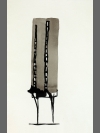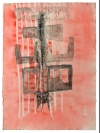
Cast in a Different Light
George Fullard and John Hoskin
17th June - 19th July 2013
Sculpture, prints, paintings and drawings from the 1950's and 60's by these two important yet often overlooked artists. The accompanying catalogue includes an introduction by curator and writer Gillian Whiteley and personal recollections of the artists by Steve Hurst and Ken Cook.
'At first glance, the artists featured in Cast in a Different Light have a good deal in common. Born in the early 1920s, they were both on active war service (Fullard in North Africa and Italy, Hoskin in Germany) and went on to make sculpture the focus of their creative practice. During the war years and immediately after, Henry Moore’s work attracted extraordinary international critical acclaim and, along with a generation of young sculptors, Fullard and Hoskin became part of what critics called the ‘phenomenon’ of postwar British sculpture.
Through the 1960s, they both showed in gallery exhibitions such as the Tate’s British Sculpture in the Sixties (1965) and their work reached new audiences in the Arts Council’s iconic series of open-air sculpture exhibitions which toured public spaces and municipal parks up and down the country. With flourishing reputations as contemporary artists, Fullard and Hoskin were in high demand and both taught at various art schools throughout the UK before becoming Head of Sculpture departments: Fullard at Chelsea and Hoskin at Bath.
However, there the commonalities end. Indeed, Fullard and Hoskin shared very little in terms of the themes, working methods and materials of their sculpture. The work of the two artists demonstrates contrasting aesthetic allegiances and a separate set of distinct cultural roots and influences. In
the 1950s and 60s, political circumstances and critical contexts shaped artistic production and informed its interpretation in particular ways and the work of the two sculptors featured in this exhibition exemplifies the polarities. In the jittery Cold War context of the 1950s, whilst Hoskin’s work shared the characteristic spikiness of the sculpture Herbert Read associated with the ‘geometry of fear’ , Fullard’s figurative sculpture was described by John Berger, the Marxist critic and regular reviewer for the New Statesman, as ‘humanist’ and ‘social realist’.
Extract from Introduction by Gillian Whitely









